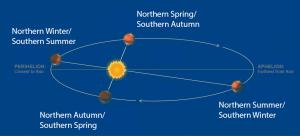Summer arrives in the northern hemisphere of Mars on October 8. It is the longest season on the Red Planet because Mars is farthest from the Sun then, so it moves slowest in its orbit around the Sun. [NASA/JPL/Caltech]
You are here
Summer Solstice
It’s summertime! Not here on Earth, of course. Instead, summer arrives today in the northern hemisphere of Mars. It’s the Red Planet’s longest season. It lasts about 178 Mars days, which is 183 Earth days.
The seasons on Mars have the same cause as those on Earth: the planet’s tilt on its axis. Right now, Mars’s north pole tilts toward the Sun. That brings the long days of summer north of the equator.
South of the equator, though, it’s the start of winter. And it’s a frigid season. Not only is it long, but Mars is farthest from the Sun during southern winter. So southern winter brings the coldest temperatures of the year. Lows in the southern hemisphere drop below minus 200 degrees Fahrenheit. And the highs typically stay well below minus 100.
The seasons bring big changes to the Martian ice caps. In the north, much of the ice cap is vaporizing, adding water and carbon dioxide to the atmosphere. And the opposite is happening in the south. Water and CO2 are freezing on the ice cap, making it bigger.
As a cap vaporizes, it stirs up dust around it, which can cause dust storms. Most northern storms are fairly small. Storms that start in the south, on the other hand, can blanket the entire planet — massive storms created by the changing of the season.
And Mars is just peeking into the dawn sky. It’s quite low in the east during twilight, so it’s hard to spot. It’s climbing higher each day, though, so it’ll be easier to see in a couple of weeks.
Script by Damond Benningfield
Get Premium Audio
Listen to today's episode of StarDate on the web the same day it airs in high-quality streaming audio without any extra ads or announcements. Choose a $8 one-month pass, or listen every day for a year for just $30.






